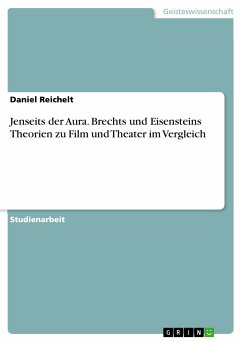Studienarbeit aus dem Jahr 2001 im Fachbereich Theaterwissenschaft, Tanz, Note: 1,0, Europa-Universität Viadrina Frankfurt (Oder) (Fakultät für Kulturwissenschaften), Veranstaltung: Der frühe sowjetische Film: Sergej Eisenstein, Sprache: Deutsch, Abstract: In the beginning of the Ninteen-twenties both Eisenstein and Brecht proclaim the neccessity of a new form of theatre. These demands appear as the result of a process setting in with the inventions of photography and film and, refering to Benjamin, finally led to the death of the bourgeois theatre. The institutions Brecht and Eisenstein conceptualize in their theoretical writings seem to have a similar outward appearance, since both, Brecht’s »theatre of the scientific age« and Eisenstein’s Prolet-kult-works as well as his silent movies, are characterized by a technical usage of theatrical elements and construction of images. Nevertheless these are superficial affinities, being unable to conceal the deep differences in the fundamentals of Brecht’s and Eisenstein’s works. While Brecht attributes his theatre to a social and political function there are no convincing clues in Eisenstein’s writings and life revealing any purpose he creates his films for beyond personal gratification. So even if similar tendencies in Eisenstein’s and Brecht’s works cannot be denied, it is also a matter of fact, that any congruences between their aesthetic instruments rather trace back to their common claim of creating something completely new than to similar theoretical developments of the choosen aestehtic forms.

